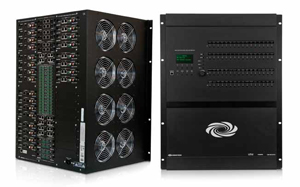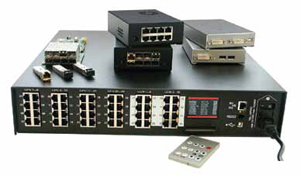Soldiering On

Matrix Routing Switchers Evolve In Digital And Analog Worlds Despite Economic Slump
by Ryan Abeling
TV One 1T-MX-6344 Matrix Switcher
Matrix routing switchers are often the brain trust for an entire corporate AV system, directing sources where to go and generally keeping everything in order. Now these products have blossomed into something bigger and better, boasting more inputs and transmission formats than ever before. However, with the recent economic slowdown, their sales have suffered considerably, causing integrators to adjust to the change in business as the corporate world waits for the impending fiscal upswing.
Matrix routing switchers have grown in size since they came into the market many years ago. As companies grew in size, so did their need for more inputs and outputs. As Glen Swanson, account manager for FSR explained, this trend in size seemed to never end. “Prior to the slowdown, the trend has been to create and install bigger matrixes. Matrix switching in the corporate environment has been consolidated to central point, giving them more flexibility, meaning anything they want, from any source, in any direction. So sizes continued to grow larger and larger. With this economic slowdown we’ve been dealing with the last two years, that’s all stopped. Matrix sales in general are way down across the board. It’s been a holding pattern for the last 18 months or so.”

Crestron DM-MD32X32 DigitalMedia Switcher
Despite the global recession, matrix-switching technology has continued to develop, particularly through mixing of analog and digital formats. RGB Spectrum primarily works with digital matrix switchers, creating “cross-format” switchers that accept and convert analog signals into DVI for routing to high-resolution displays. While demand for analog switchers currently continues, RGB product marketing manager JX Loeb sees that shifting. “There’s a strong trend to digital, though some people are still buying analog switchers. We see that changing because as more sources become HDMI, and there are copy protection issues with HDCP. With the migration to digital signals, there is also an increase in copy protection challenges, such as how many displays can you can route to with an individual source.”
A daily selection of the top stories for AV integrators, resellers and consultants. Sign up below.
Even with more signals becoming HDMI, some companies, like Atlona Technologies have retained their interest in analog switchers that work with Cat-5 or Cat-6. PR director for Atlona, Joshua Carlson, noted, “Essentially we’ve realized HDMI has its limit, so for much of our Professional line of matrix switchers, we use Cat-5 or Cat-6 so they can extend up to 200 feet without signal degradation. Cat-5 is much cheaper than HDMI anyways. We also have repeater units placed in each of those models to allow it to extend another 200 feet. We’ve tried to make these products more economical and convenient for installers. Another big thing with our Professional line is that they’re cardbased systems, so if you wanted to change formats, this makes it easy to change from Cat-5 to HDMI.”
Working with integrators to make margins is an important goal for most matrix switcher manufacturers. FSR’s Swanson mentioned the significance of choosing the right switcher by discerning its capabilities. “The big thing when choosing a matrix switcher is selecting it by the breadth of features and specifications. A lot of people choose by just bandwidth, and they don’t care how it’s achieved. The result is that the image quality suffers dramatically, and then they end up with more service calls. Integrators can help themselves by paying attention to achieving flatness throughout the entire frequency range and by making sure the switcher isn’t causing artifacts or image disruption when optimizing these switchers in a system.”

IHSE Draco Major
RGB has installed a web-friendly control panel (WCP) in its switchers, among other innovations that allow for easier installation, giving contractors the ability to focus on other aspects of a project. “By finding a switcher that has the right tools to make the installation go easier, a contractor will make better margins,” Loeb said. “We’re constantly adding diagnostics to our command set and WCP. We also have indicator lights on the back panels of our switchers that show if a card isn’t communicating with the back plane, or if the card isn’t seeing an input. Immediately you can start tracing the problem upstream to your source. They’re sort of a fast way to see that the signal isn’t getting to the switch. They also offer extensive EDID management. We paid a lot of attention to help streamline trouble shooting.”
As switchers become smarter and less problematic during installs, the technology overall continues to evolve. “The future is a completely Cat-5- based solution for large scale video routing using the new format HDBaseT, provided that it can easily convert back into HDMI or DVI based formats commonly used in commercial installations,” Carlson noted. “This is only logical, when you consider the scope and need for constant expansion that is prevalent in the commercial world, especially with digital signage, a format with the capabilities of HDMI but without the distance limitations. This would be greatly beneficial to both installers and their clients, not to mention cost-savings of using Cat-5 for all cabling.”
